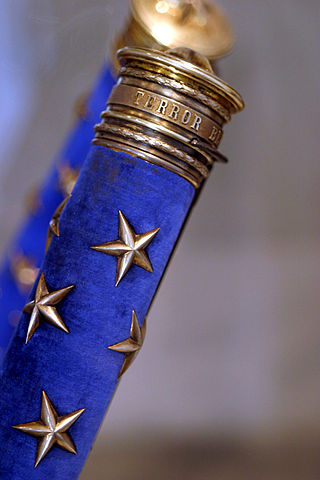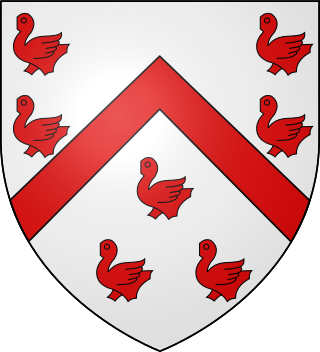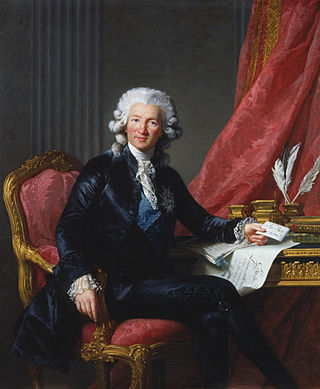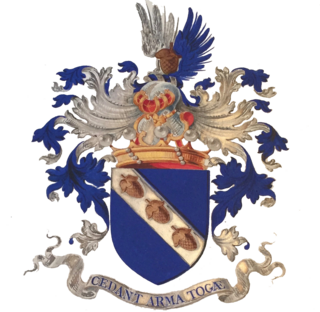
Henri-Benjamin Constant de Rebecque, or simply Benjamin Constant, was a Swiss political thinker, activist and writer on political theory and religion.

Marshal of France is a French military distinction, rather than a military rank, that is awarded to generals for exceptional achievements. The title has been awarded since 1185, though briefly abolished (1793–1804) and for a period dormant (1870–1916). It was one of the Great Officers of the Crown of France during the Ancien Régime and Bourbon Restoration, and one of the Grand Dignitaries of the Empire during the First French Empire.

Paul Henri Benjamin Balluet d'Estournelles de Constant, Baron de Constant de Rebecque, was a French diplomat and politician, advocate of international arbitration and winner of the 1909 Nobel Prize for Peace.

The French nobility was a privileged social class in France from the Middle Ages until its abolition on 23 June 1790 during the French Revolution.

The House of Aumont is an ancient French noble house which takes its name from Aumont, a small commune in the department of the Somme. The dukedom of Aumont in the peerage of France was created in 1665 for Antoine d'Aumont de Rochebaron (1601–1669), Marquis of Isles. For over two centuries, the Dukes of Aumont held the position of First Gentleman of the Bedchamber to the king.

Under the Ancien Régime of France, the Nobles of the Robe or Nobles of the Gown were French aristocrats whose rank came from holding certain judicial or administrative posts. As a rule, the positions did not of themselves give the holder a title of nobility, such as baron or viscount, but they were almost always attached to a specific function. The offices were often hereditary, and by 1789, most of the holders had inherited their positions. The most influential of them were the 1,100 members of the 13 parlements, or courts of appeal.

Prince of Ligne is a title of Belgian nobility that belongs to the House of Ligne, which goes back to the eleventh century. It owes its name to the village in which it originated, between Ath and Tournai. The lords of Ligne belonged to the entourage of the Count of Hainaut at the time of the Crusades.

Henri Marie Jacques Hyacinthe, Baron van de Werve et de Schilde was a Belgian nobleman.

The House of Merode is one of the most prominent families of the Belgian nobility. The House of Merode originates from the village of Merode. Over the last five centuries different branches bore noble titles and had estates on the territories of the modern states of Germany, Belgium, the Netherlands, France and Austria. Through marriage the house is connected with many prominent European noble families. The House of Merode played an important role in the history of the Southern Netherlands and the Kingdom of Belgium.

The House of Castellane is a very ancient French noble house originating in Provence and descended from Thibault, count of Arles in the 9th century.

Jean Victor de Constant Rebecque was a Swiss mercenary and member of the house of Constant de Rebecque who distinguished himself in Dutch service. As chief-of-staff of the Netherlands Mobile Army he countermanded the order of the Duke of Wellington to evacuate Dutch troops from Quatre Bras on the eve of the Battle of Quatre Bras, thereby preventing Marshal Michel Ney from occupying that strategic crossroads.

The House of Monpezat is a French old bourgeois family from the province of Béarn associated with the Danish royal family by marriage after 1967, when Henri de Laborde de Monpezat wed Princess Margrethe of Denmark, then the heir presumptive of the ruling House of Glücksburg, who was subsequently the Queen of Denmark as Margrethe II. The current Danish monarch, King Frederik X is agnatically a Monpezat.

The House of Bethune is an ancient French noble house from the province of Artois in the north of France whose proven filiation dates back to Guillaume de Béthune who made his will in 1213. This family became extinct in 1807 with Maximilien-Alexandre de Béthune, Duke of Sully (1784-1807).

Nobility is a social class found in many societies that have an aristocracy. It is normally ranked immediately below royalty. Nobility has often been an estate of the realm with many exclusive functions and characteristics. The characteristics associated with nobility may constitute substantial advantages over or relative to non-nobles or simply formal functions, and vary by country and by era. Membership in the nobility, including rights and responsibilities, is typically hereditary and patrilineal.

Louis Marie Pantaléon Costa, Marquis de Beauregard was a French statesman, archaeologist, historian and ornithologist.

The Parthon de Von family is a Belgian noble family stemming from Châteauroux in France.

The Van der Noot family is a Belgian noble family. The title of Count van der Noot is a title created by Emperor Charles VI on 16 May 1716. Since then this title belongs to the Belgian nobility.

The House of Hénin is a family of the Belgian high nobility, one of its branches was titled Prince of Chimay. Alliances were made with important Spanish noble families such as house of Borja and the house of Velasco.

The Coppet group, also known as the Coppet circle, was an informal intellectual and literary gathering centred on Germaine de Staël during the time period between the establishment of the Napoleonic First Empire (1804) and the Bourbon Restoration of 1814–1815. The name comes from Coppet Castle in Switzerland.



















